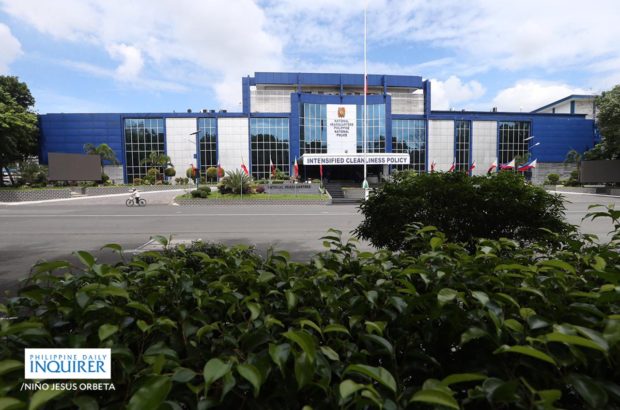
The Philippine National Police Headquarters in Camp Crame, Quezon City on Tuesday, June 15, 2021. Niño Jesus Orbeta/Philippine Daily Inquirer
MANILA, Philippines — The Philippine National Police (PNP) has recommended placing over 100 municipalities and cities under the “red category” of the election areas of concern, or the highest alert level under the new system implemented by the Commission on Election (Comelec).
According to PNP spokesperson Col. Jean Fajardo, the police force is still awaiting the final list from Comelec, which includes the over 100 municipalities and 14 cities it suggested to be under the red category.
“’Yong ibinigay po nating listahan sa Comelec sometime in the middle of February po ay kailangan pa nga pong dumaan sa sarili po nilang assessment and validation, at […] pwede pa nga po itong magbago depende pa rin po ito sa current at prevailing political landscape do’n po sa mga areas na naisama po doon sa category yellow, orange, at red po,” Fajardo told ABS-CBN Teleradyo’s Sakto.
(The list that we gave Comelec sometime in the middle of February still requires their own assessment and validation, and this can change depending on the current and prevailing political landscape in the said areas included in the yellow, orange, and red categories.)
“We are still waiting for the initial list na ilalabas po ng Comelec, but sa initial po na list ng PNP na sinubmit po ay meron po tayong mga at least, 100 po na mga towns and municipalities na ni-recommend na mapasailalim po sa red area, and 14 cities,” she added.
(We are still waiting for the initial list from Comelec, but in the initial list of the PNP we have at least 100 municipalities and 14 cities recommended to be under the red category.)
Fajardo explained that PNP and Comelec are now following a new system in terms of classifying electoral concerns per area, doing away with the term ‘election hotspots’ to avoid panic and confusion.
These areas of concern would be subdivided into four categories, in order of increasing concern: green, yellow, orange, and red.
“Base doon sa latest na ibinigay po na guidelines po ng Comelec ay hindi na po natin ginagamit ang ‘hotspot’ because nga po kapag sinasabi nating hotspots ay nagkakaroon po ng ‘ika nga eh pangamba na ‘yong kanilang area ay magiging magulo at ika nga ay mainit,” she explained.
(Based on the latest guidelines from Comelec, we would no longer use the term ‘hotspot’ because when we say an area is a hotspot, there is a fear that their area would be under lawless violence and that rivalries would be intense.)
“Kaya po ang inilabas po na proper term po ng Comelec, ito po ay tinatawag nating mga election areas of concern kaya po ito po ay nahahati sa apat na kategorya: green, yellow, orange, and red,” she added.
(That’s why the proper term issued by Comelec, is to call these as election areas of concern which are subdivided into four categories: green, yellow, orange, and red.)
For an area to be placed under red category, it must have a combination of all the parameters for those under the yellow category — like previous election-related incidents, intense political rivalries, the existence of partisan armed groups, and if the area was under Comelec control before.
Local armed groups, like the presence of alleged communist insurgents, will also be a factor.
Comelec initially said that the list of areas of election concern would be released on March 31, but the poll body decided to defer the publication and review and reverify the status of the following areas.
READ: Comelec to announce areas of election concern by March 31
READ: Comelec reverification of election ‘areas of concern’ ongoing
Last December, PNP chief Gen. Dionardo Carlos said that there would be over 500 areas that would be considered as areas of concern.
READ: PNP: Over 500 areas considered election hotspots; 39 towns, 7 cities under red category
The Philippines has had a long history of election-related violence, with the single-largest killing of journalists in the world happening during election time, when a convoy of media personalities and female supporters of Maguindanao 2nd District Esmael “Toto” Mangudadatu were ambushed by armed men in 2009.
Mangudadatu was then seeking the gubernatorial seat of Maguindanao, challenging the Ampatuans’ grip on the province. Members of the Ampatuan clan including former Datu Unsay mayor Andal Ampatuan Jr. were convicted last December 2019 for the incident.
READ: Andal Ampatuan Jr., kin guilty for Maguindanao massacre of 57 people
As early as September 2021, there were reports of attacks believed to be motivated by the elections, including a grenade-throwing incident at the ancestral home of Cagayan de Oro 2nd District Rep. Rufus Rodriguez.
No one was harmed after the grenade did not explode.
READ: Grenade thrown at Rep. Rufus Rodriguez residence in Cagayan de Oro